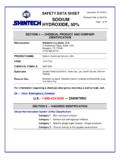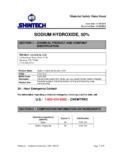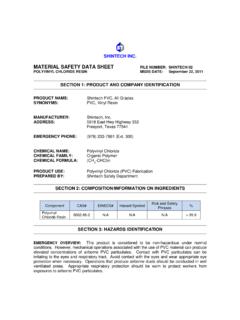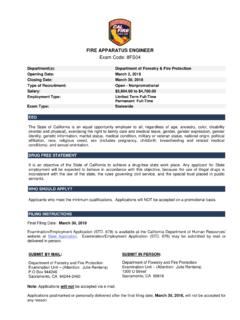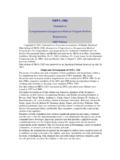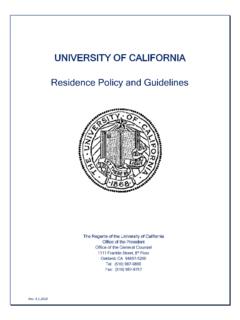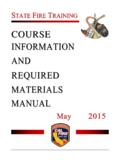Transcription of SECTION 1: PRODUCT AND COMPANY …
1 1 SHINTECH INC. SAFETY DATA SHEET FILE NUMBER: SHINTECH 02 POLYVINYL CHLORIDE RESIN REVISION DATE: May 01, 2015 SUPERCEDES DATE: April 20, 2015 SECTION 1: PRODUCT AND COMPANY IDENTIFICATION PRODUCT NAME: Shintech PVC, All Grades SYNONYMS: PVC, Vinyl Resin, polyvinyl chloride MANUFACTURER: Shintech, Inc. ADDRESS: 5618 East Highway 332 Freeport, Texas 77541 EMERGENCY PHONE: (979) 233-7861 (Ext. 300) CHEMICAL NAME: Polyvinyl Chloride CHEMICAL FAMILY: Organic Polymer CHEMICAL FORMULA: (CH2-CHCl)n CAS No.: 9002-86-2 PRODUCT USE: Polyvinyl Chloride (PVC) Fabrication PREPARED BY: Shintech Safety Department SECTION 2: HAZARDS IDENTIFICATION GHS Classification / Hazard Statement Codes: Not Classified OVERVIEW OF HEALTH EFFECTS: This PRODUCT does not present health hazards under normal conditions of use.
2 However, mechanical operations associated with the use of PVC material can produce elevated concentrations of airborne PVC particulates. Contact with PVC particulates can be irritating to the eyes and respiratory tract. Avoid contact with the eyes and wear appropriate eye protection when necessary. Operations that produce airborne dusts should be conducted in well ventilated areas. When exposures to airborne PVC particulates exceed the applicable exposure limits, appropriate respiratory protection must be worn. PRIMARY ROUTES OF ENTRY: Inhalation (process emission from elevated temperature or process particulates), skin and/or eye contact TARGET ORGANS: Eyes, skin, and respiratory system 2 SIGNS AND SYMPTOMS OF EXPOSURE: Irritation to the eyes, skin, throat and upper respiratory system.
3 POTENTIAL HEALTH EFFECTS: EYES: PVC particles may cause irritation of the eyes. SKIN: PVC particles may cause mechanical irritation or moderate allergic dermatitis. INGESTION: Ingestion of this PRODUCT under normal conditions does not contribute to any known adverse health effects. INHALATION: Inhalation of high concentrations of PVC particles (process emission from elevated temperature or process particulates) may cause respiratory irritation. CARCINOGEN STATUS: This PRODUCT is not considered carcinogenic by OSHA, NTP, or IARC. CONDITIONS GENERALLY RECOGNIZED: PVC particulates may aggravate any pre-existing respiratory conditions or allergies. SECTION 3: COMPOSITION/INFORMATION ON INGREDIENTS Component CAS# EINECS# GHS Hazard Statement Codes % Polyvinyl Chloride Resin 9002-86-2 N/A N/A > SECTION 4: FIRST AID MEASURES EYES: Immediately flush the eyes with large amounts of room temperature water for a minimum of 15 minutes.
4 Hold the eyelids apart during the flushing operation. Get immediate medical attention if irritation persists. SKIN: Wash affected area with soap and water. Get immediate medical attention if irritation persists. INGESTION: Ingestion of this PRODUCT under normal conditions does not contribute to any known adverse health effects. If large amounts are ingested get medical attention. INHALATION: Remove the person from the exposure and move to fresh air. Get immediate medical attention if severe coughing or breathing difficulty occurs. 3 SECTION 5: fire -FIGHTING MEASURES FLASHPOINT: Not Applicable FLAMMABLE LIMITS (% VOLUME IN AIR) Lower Explosive Limit (LEL): Not Applicable Upper Explosive Limit (UEL): Not Applicable AUTOIGNITION TEMPERATURE: 945oF EXTINGUISHING MEDIA: Water, dry powder, foam, carbon dioxide, or sand is recommended.
5 Water spray is recommended to cool or protect exposed materials or structures. Carbon dioxide can displace oxygen. Use caution when applying carbon dioxide inside confined spaces. Collect contaminated fire -fighting water separately. fire FIGHTING PROCEDURES: Avoid inhalation of material or combustion by-products. Wear fire fighter s protective clothing and a NIOSH-approved self-contained breathing apparatus (SCBA). UNUSUAL fire AND EXPLOSIVE HAZARDS: Exposure to fire or explosions can produce hydrogen chloride. NFPA: Health 0 (Normal) HMIS: Health 0 (none) fire 1 (Above 200 F) Flammability 1 (Slight) Reactivity 0 (Stable) Reactivity 0 (none) Special None PPE A (safety glasses) SECTION 6: ACCIDENTAL RELEASE MEASURES PERSONAL PROTECTIVE EQUIPMENT: Use the personal protective equipment recommended in SECTION 8.
6 SPILL PROCEDURES: Contain spill immediately. Restrict access. Non-recoverable PRODUCT , contaminated soil, debris and other materials should be placed in proper containers for reclamation or disposal. Avoid generating dust during containment, clean up, and disposal. DISPOSAL: Follow the procedures recommended in SECTION 13. SECTION 7: HANDLING AND STORAGE HANDLING: Wear personal protective equipment and follow the exposure control measures recommended in SECTION 8. Avoid contact with eyes and prolonged breathing of airborne PVC. PVC can acquire a substantial static electrical charge. Handling and processing equipment should have electrical grounding. Use good housekeeping practices to minimize PVC particulates, especially dust, from accumulating and minimize dust from becoming airborne.
7 Wash thoroughly after handling. 4 STORAGE: Store in a cool, dry, properly ventilated place and keep isolated from open flames and other sources of ignition. SECTION 8: EXPOSURE CONTROLS/PERSONAL PROTECTION ENGINEERING CONTROLS: Provide general and/or local exhaust ventilation to control airborne levels of PVC dust below the exposure standards and guidelines. Local exhaust ventilation is preferred because it is capable of controlling contaminant emissions at the source and preventing dispersion into the general work area. For additional information on ventilation, refer to the ACGIH text, Industrial Ventilation, a Manual of Recommended Practices. EYE PROTECTION: Wear ANSI approved safety glasses with side shields and/or an appropriate full-face shield.
8 All eye protection should be selected and worn in accordance with the general OSHA PPE standard (29 CFR ) and the OSHA eye and face protection standard (29 CFR ). SKIN PROTECTION: Under normal conditions, the use of additional PPE is not necessary to protect the skin. However, protective clothing, including gloves, aprons, and other outer garments may be desirable in extremely dusty areas. All PPE for skin protection should be selected and worn in accordance with the general OSHA PPE standard (29 CFR ), the OSHA eye and face protection standard (29 CFR ), and the OSHA hand protection standard (29 CFR ). RESPIRATORY PROTECTION: Use a NIOSH-approved air purifying respirator with an N95 cartridge where airborne concentrations are expected to exceed exposure limits.
9 All respirators should be selected and worn in accordance with the general OSHA PPE standard (29 CFR ) and the OSHA respiratory protection standard (29 CFR ). EXPOSURE GUIDELINES: COMPONENT OSHA PEL ACGIH TLV NIOSH IDLH Dust (total) 15 mg/m3 (TWA) Not Established Not Established Dust (respirable) 5 mg/m3 (TWA) 1 mg/m3 (TWA) Not Established SECTION 9: PHYSICAL AND CHEMICAL PROPERTIES PHYSICAL STATE: Granulate Solid (free flowing) COLOR: White ODOR: Odorless ODOR THRESHOLD: Not Applicable PH: Not Applicable BOILING POINT/BOILING RANGE Not Applicable MELTING/FREEZING POINT: Not Applicable FLASH POINT: Not Applicable EVAPORATION RATE: Not Applicable FLAMMABILITY SOLID: Not Applicable UPPER/LOWER EXPLOSIVE LIMITS: Not Applicable VAPOR PRESSURE: Not Applicable VAPOR DENSITY (AIR): Not Applicable 5 WATER SOLUBILITY.
10 Not Soluble RELATIVE DENSITY (SPECIFIC GRAVITY): WATER SOLUBILITY: Not Soluble PARTITION COEFFICIENT: n-octanol/water: No Data Available AUTO IGNITION TEMPERATURE: 945oF DECOMPOSITION TEMPERATURE : No Data Available VISCOSITY: Not Applicable To Solids MOLECULAR FORMULA: (CH2-CHCl)n MOLECULAR WEIGHT: 20,000 150,000 g/mole SECTION 10: STABILITY AND REACTIVITY STABILITY: Stable at normal temperatures and pressures CONDITIONS TO AVOID: Avoid all possible sources of ignition, heat and flames. INCOMPATIBLE MATERIALS: Avoid contact with acetal or acetal copolymers and amines (derivates of ammonia). HAZARDOUS DECOMPOSITION PRODUCTS: Mostly Hydrogen Chloride. HAZARDOUS POLYMERIZATION: Has not been reported. SECTION 11: TOXICOLOGICAL INFORMATION TOXICITY DATA: There is limited toxicity information available for this PRODUCT .
